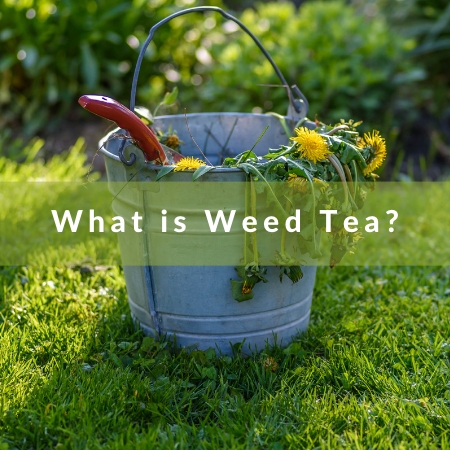What is Weed Tea?
Weed tea is taking unwanted plants from your garden and soaking them for days in water. It’s basically just a cup of tea for your garden! This is a cheap, easy, and efficient way of making liquid fertilizer!
Some people soak their plants for weeks at a time, but that’s not the method we are going to discuss in this blog. Soaking the plants for weeks creates anaerobic conditions… a different blog for another day!

What types of plants work best?
This is a great question because not all plants contain the same amount of nutrients. Clover is high in nitrogen because it is a nitrogen-fixing plant. In fact, most legume plants would be great for weed tea! Comfrey is known as a permaculture wonder plant, and it too is great for weed tea. It’s rich in phosphorus, potassium, vitamins, and other trace minerals. Stinging nettle is another. It’s high in iron, zinc, selenium, and magnesium. It’s also a natural pest repellant. By using a mix of different weeds or cuttings from the garden, you will diversify the nutrients you’re extracting and spreading.
When would I use weed tea?
You could use weed tea at any time of day, or any time of the year. It is a very mild fertilizer so you may choose to use it at times you believe your plants are most vulnerable. That might be in the high heat of summer, or perhaps during times of pest or climate stress. Weed tea can feed the soil, but it can also be used as a foliage spray!
Do you have tips or tricks?
The best advice we can give is not to add plants with seed heads unless you want to redistribute them all over the garden. The seed heads should be disposed of, or the plant not be used at all if you would prefer not to see the plant spreading. We actually really love the dandelion though, so we have absolutely no issue adding seed heads from these plants into the tea.
How do I make it?
Step 1: Take all of the plants you are weeding out and throw them into a large bucket or tote.
Step 2: Once the bucket is half filled with plant material, fill it with water all the way to the top. Or, leave the bucket out in the rain and let it fill with fresh rainwater!
Step 3: If you’re in an area where mosquitos are an issue, be sure to cover the bucket! You don’t want to be contributing to a pesky mosquito population!
Step 4: Stir it daily. It’s only in there for a couple of days so this isn’t too much work. I keep mine by the back door so I can do it quickly as I walk out of the house. I use a stick so the thistles don’t poke me!
Step 5: Strain off the liquid and use it in your garden. Or, use it in a spray bottle for foliage spray!
What do I do with the plants after it’s finished?
Now that you’ve extracted nutrients from the plants, you have a soggy limp mass of leaves and stems. You could try these four things:
1. Throw them into your compost! It’s easy and the job is now done!
2. Try an aerobic digester to get the last of the goods. See the video above.
3. Lay the weeds out flat in the sun and let them dry out for a couple of days. Then use them to mulch around your plants.
4. Bury them, hugelkultur style! (Just be aware of those seed heads!)
Weed tea is super easy to make, and it’s free. The nutrients are already in a plant available form, making it easy for uptake once distributed. Check out this YouTube short which shows you just how easy it is to make it. So easy the kids can to do it! (I paid my kids 10c per weed pulled… they made bank, and had fun. And I got good fertilizer for the garden!)





